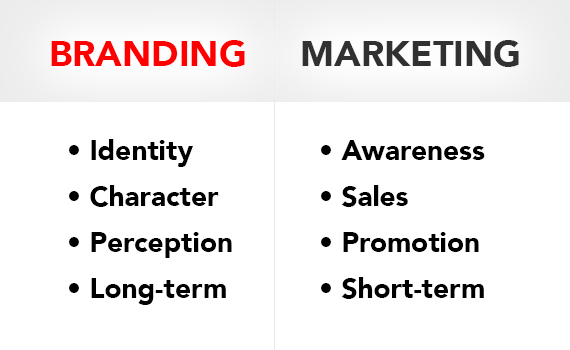Branding vs Marketing
Posted by Clash Printing Atlanta on 22nd Nov 2024
If you're confused about branding vs marketing, you're not alone. Branding establishes your company's identity and builds long-term recognition, while marketing promotes your products to drive sales. This article will discuss their main differences and show how they work together to support business success.

Key Takeaways
-
Branding establishes a business's unique identity, fostering customer loyalty by creating emotional connections, while marketing focuses on promoting products to drive immediate sales.
-
Branding and marketing are interdependent; branding is the foundation for effective marketing strategies, which must resonate with the brand's established identity.
-
Measuring branding success involves metrics like brand awareness and loyalty, while marketing effectiveness is evaluated through conversion rates and referral leads.
Understanding Branding and Marketing
Grasping the essence of branding and marketing unlocks their potential. Branding shapes a business's identity, creating a unique and memorable image. It fosters recognition and trust, resulting in customer loyalty and revenue.
On the other hand, marketing involves strategically promoting products or services to reach the target audience and drive sales. While branding provides clarity and direction, marketing executes the plan to bring the brand's message to the audience. Together, they form the backbone of any successful business strategy.
Defining Branding
Branding is more than just a logo or a catchy tagline; it shapes a business's identity. It involves graphic design, but mainly it's creating a unique identity for a company or product by emphasizing core principles, mission, and unique aspects. Elements such as the logo, color palette, fonts, and overall image contribute to a strong brand identity. Emotional connection helps brands form lasting relationships by consistently addressing customer needs. This creates a compelling reason for customers to choose a specific business over competitors.
The purpose of branding is to establish recognition and a long-term promise, leading to positive customer impressions. Successful branding includes customer experiences and business operations, extending beyond mere aesthetics.
For instance, Apple's branding promotes class, innovation, and minimalism, creating a strong emotional connection with its customers. Effective branding ultimately aims to make the brand more likable and relatable, turning customers into advocates.
Defining Marketing
Marketing involves promoting and selling products or services through market research, advertising, sales, and branding. According to the American Marketing Association (AMA), marketing involves creating, communicating, delivering, and exchanging value offerings. A marketing strategy involves understanding the product's usefulness and planning its promotion to escalate sales through targeted efforts. Effective marketing campaigns utilize multiple channels to reach the audience, including digital marketing and traditional methods.
Marketing activities range from social media and content creation to public relations and customer engagement, with various marketing examples. Key components include product, pricing strategy, promotional efforts, and distribution.
For instance, effective marketing might involve a mix of social media marketing, email marketing, and content marketing to engage and convert potential customers. These campaigns must adapt over time based on consumer sentiment, competition, and economic factors to remain effective.
Key Differences Between Branding and Marketing

Recognizing the differences between branding and marketing is crucial for a cohesive business strategy. While branding constitutes the identity and character of a business, marketing focuses on building awareness and driving sales. Branding defines a company's unique identity, and marketing is the tactical approach to promoting products or services.
Though distinct, these activities are interdependent, with branding providing the foundation for marketing plans. Together, they support long-term success by informing and complementing each other.
Identity vs. Promotion
Branding focuses on creating a unique identity for the company, while marketing involves promoting that identity to the target audience. Branding centers on how a company wants consumers to perceive it, focusing on core values and mission. For instance, Apple's branding emphasizes innovation and minimalism, aiming to store a particular perception in customers' minds. Conversely, marketing entails the tactics used to share the brand with target audiences, such as advertising campaigns, social media posts, and promotional events.
A strong brand identity offers a unified tone of voice and meaningful elements for all marketing efforts. Understanding the company's identity and target audience values is crucial for successful branding and marketing campaigns.
Effective branding aims to make the brand more relatable, turning customers into advocates who promote the brand. This holistic approach ensures that marketing efforts resonate with the audience, enhancing overall brand perception.
Long-term vs. Short-term Goals
Branding and marketing also differ in their focus on long-term versus short-term goals. Branding aims to cultivate long-term customer relationships and loyalty, creating a lasting identity for the company. This contrasts with marketing's primary goal of driving immediate sales and engaging audiences through timely and targeted efforts.
While marketing strategies may result in quick gains, long-term branding efforts enhance customer loyalty and retention, ultimately leading to sustained success.
Emotional Connection vs. Tactical Execution
Branding seeks to forge deep emotional connections with consumers, whereas marketing employs various tactics to stimulate sales. Emotional connections built through branding can significantly enhance the effectiveness of marketing campaigns. For example, Coca-Cola's holiday campaigns, storytelling, and overall branding elements create deep emotional connections, making its marketing efforts more impactful.
Modern branding activities often include creating buzz and seeking feedback on social media, which supports tactical marketing strategies. This integrated approach ensures that marketing efforts resonate emotionally with the target audience, driving both engagement and sales.
How Branding and Marketing Work Together

Branding and marketing are two sides of the same coin, each playing a crucial role in business success. Branding serves as the foundation for marketing strategies, guiding the development of specific promotional activities. Marketing branding utilizes various methods and tactics to communicate the brand identity and drive sales.
A well-executed marketing strategy helps sustain the brand, creating a cohesive message that resonates with the audience. Together, branding and marketing efforts enhance business success by creating a unified and compelling brand presence.
Building a Strong Brand Identity
A strong brand identity offers a unified tone of voice and meaningful elements for all marketing efforts. This identity acts as a toolbox for marketing objectives, guiding the execution of strategies. For instance, Nike's branding of "getting on the court" and pushing for excellence underpins its marketing campaigns, demonstrating the synergy between branding and marketing efforts. Effective branding strategies use visuals and storytelling to create a memorable connection with the audience. Customers who resonate with a brand become true advocates, fostering deeper loyalty.
Adapting to customer preferences can lead to significant changes in branding strategy, enhancing relevance. For example, a small bakery enhanced its customer experience through branding efforts like interior redesign and marketing strategies like hosting community events, all while providing exceptional customer service and staying attuned to market trends.
Enhancing Marketing Campaigns
Branding enhances marketing campaigns, making them more impactful and memorable. For example, apparel brands use social media ads to share their commitment to values like sustainability and ethical production. A key marketing tactic for an apparel company might involve engaging customers through targeted social media campaigns, demonstrating branding's support for marketing efforts.
Similarly, a small bakery might host promotional events to boost brand awareness, which will in turn help drive sales when they launch a new marketing campaign – demonstrating the synergy between branding and marketing. These integrated strategies ensure campaigns resonate with the audience, fostering engagement and driving sales.
Case Studies of Successful Integration
Real-world examples of effective branding and marketing integration include Starbucks, Coca-Cola, and Nike. Starbucks creates a unique and consistent brand experience, building strong emotional connections with its customers. Similarly, Coca-Cola's branding emphasizes its role in life's happiest moments, reinforcing its marketing campaigns. These companies demonstrate how branding's emotional resonance can amplify marketing efforts, turning potential customers into loyal advocates.
Nike's 'Find Your Greatness' campaign promotes personal achievements over championship trophies, demonstrating the power of branding in marketing campaigns. The 'Just Do It' campaign emphasizes motivation and perseverance, promoting sportsmanship and health, highlighting the synergy between branding and marketing efforts.
These case studies illustrate how a cohesive brand strategy can enhance marketing effectiveness.
Practical Examples of Branding and Marketing

Practical examples of branding and marketing in action can provide valuable insights into how these strategies work together. Successful branding involves clearly defined purposes and visions that guide a brand's direction in the market.
Here, we will explore how an apparel company, a small bakery, and a toy store have effectively utilized branding and marketing to achieve their business goals.
Apparel Company Example
A local apparel company utilized branding and marketing strategies to engage customers and drive sales. In this example, the apparel company utilized a social media ad campaign as its primary marketing tactic, showcasing its commitment to social justice and a cause many of its customer base were passionate about.
Their effort made an impact and created goodwill and emotional association in their customer's minds with their brand. The company then created a t-shirt in support of the cause with a catchy slogan, and were able to drive sales and donate portion of sales to the social cause. In the end, this win-win example is how to blend branding with marketing.
Local Bakery Example
To strengthen its brand identity, a local bakery renovated some areas and redesigned its interior decor to create a warm and inviting atmosphere where patrons could enjoy reading books and listening to podcasts or music. The owner organized a special event and distributed promotional materials to promote the new look and attract customers, fluidly moving from branding to marketing.
The interior renovation redesign (branding) and promotional events (marketing) significantly enhanced the bakery's appeal and thus noticeably improved customer engagement and sales. This example highlights how branding and marketing work together to create results and make an impact.
Toy Store Example
A toy store also utilized branding and marketing to create a renewed customer perception and drive sales. In this case, the brand identity needed to be refreshed to properly convey its values.
Conducting customer research is a critical step in helping a business understand its customer preferences and values. And in doing the research, the toy store learned that customers care about reducing plastic waste. They updated their branding, printed materials, and visual identity accordingly. This reassured their customers that they are listening, and encouraged a more loyal support of their local toy store.
These activities highlight the difference between branding and marketing, showcasing how they work hand in hand .
Measuring the Impact of Branding and Marketing

Measuring the impact of branding and marketing efforts is crucial for understanding their effectiveness and making informed decisions. Different metrics are required for branding and marketing, highlighting their distinct roles. Branding focuses on long-term customer relationships and loyalty, while marketing aims to drive immediate sales.
Businesses can refine their strategies by evaluating these efforts to enhance overall brand performance and customer engagement. Let's explore the specific metrics used to measure the impact of branding and marketing.
Metrics for Branding
Several key metrics can be used to gauge the success of branding efforts. For example, Brand awareness measures how well consumers recognize a brand and its products, often assessed through surveys that measure both aided and unaided recognition.
Brand engagement reflects the level of interaction between consumers and a brand's various touchpoints. Brand sentiment analyzes consumer feelings towards a brand, assessing whether they are positive or negative.
Finally, brand loyalty can be gauged using a scoring method, which measures how likely customers are to recommend a brand. These metrics provide valuable insights into the effectiveness of branding efforts and their impact on customer loyalty and perception.
Metrics for Marketing
Marketing efforts are evaluated using different metrics that focus on immediate results and sales performance. Conversion rates measure the proportion of visitors who take a desired action on a marketing platform, indicating the effectiveness of a campaign in turning prospects into customers.
Referral leads, which have a higher lifetime customer value and a higher conversion rate than standard marketing-generated leads, are also crucial metrics. These metrics help businesses understand the profitability of their marketing efforts and refine their strategies to drive better results.
Common Misconceptions About Branding and Marketing
Despite their importance, branding and marketing are often misunderstood, leading to common misconceptions. Many confuse these terms or believe they are synonymous, overlooking their distinct meanings and roles. Addressing these misconceptions is essential for businesses to leverage branding and marketing strategies effectively.
Let's explore two prevalent misconceptions: that branding is just a logo and that marketing is only advertising.
Branding is Just a Logo
One common misconception is that branding is merely about having a logo. However, effective branding goes beyond logos, incorporating values, mission, and overall customer perception. Branding encompasses a company's entire identity, including its visual elements, core principles, and emotional connections with customers.
Understanding branding in its entirety is crucial for building lasting relationships with customers and creating a strong brand identity.
Marketing is Only Advertising
Another misconception is that marketing is solely about advertising. In reality, marketing involves a wide range of strategies and tactics used to promote products and engage target audiences. For instance, an apparel company uses social media marketing to reflect its brand values and identity, demonstrating marketing beyond traditional advertising.
A small bakery's promotional events and a toy store's update of its materials and visual identity based on customer research also showcase marketing efforts that extend beyond advertising. Effective marketing encompasses various activities, including market research, customer engagement, and content creation, to drive sales and enhance brand perception.
Branding vs Marketing Summary
In conclusion, understanding the differences and synergies between branding and marketing is essential for any business aiming for long-term success. Branding focuses on creating a unique identity and forging emotional connections with customers, while marketing involves the tactical promotion of products and services to drive immediate sales. By integrating both branding and marketing efforts, businesses can create a cohesive and compelling brand presence that resonates with their audience. Remember, effective branding sets the foundation for successful marketing strategies, and together, they can elevate your business to new heights.
Frequently Asked Questions
What is the primary difference between branding and marketing?
The primary difference between branding and marketing lies in their focus; branding aims to establish a unique identity and emotional connection with customers, whereas marketing concentrates on promoting products or services to drive sales.
How do branding and marketing work together?
Branding lays the groundwork for effective marketing by shaping the brand identity, which marketing then communicates through various strategies to enhance visibility and drive sales. Together, they create a unified presence that resonates with consumers.
Can you give an example of a successful branding and marketing integration?
Nike's 'Find Your Greatness' campaign effectively integrates branding and marketing by focusing on personal achievements and motivation, showcasing how powerful messaging can elevate a brand's identity. This campaign demonstrates the effectiveness of aligning marketing strategies with branding principles.
What are some key metrics for measuring branding success?
To measure branding success effectively, focus on key metrics such as brand awareness, brand engagement, brand sentiment, and brand loyalty. These indicators will help you assess the impact of your branding strategies on customer perception and loyalty.
What are some common misconceptions about branding and marketing?
Branding is often mistakenly seen as merely a logo, while marketing is reduced to just advertising. In reality, branding encompasses values and customer perceptions, and marketing involves diverse strategies beyond advertising, such as research and engagement.
(678) 235-3464






